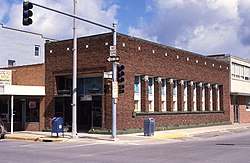Algona, Iowa
| Algona, Iowa | |
|---|---|
| City | |

Henry Adams Building
|
|
 Location of Algona, Iowa |
|
| Coordinates: 43°4′13″N 94°13′47″W / 43.07028°N 94.22972°WCoordinates: 43°4′13″N 94°13′47″W / 43.07028°N 94.22972°W | |
| Country |
|
| State |
|
| County | Kossuth |
| Area | |
| • Total | 4.51 sq mi (11.68 km2) |
| • Land | 4.49 sq mi (11.63 km2) |
| • Water | 0.02 sq mi (0.05 km2) |
| Elevation | 1,194 ft (364 m) |
| Population (2010) | |
| • Total | 5,560 |
| • Estimate (2012) | 5,509 |
| • Density | 1,238.3/sq mi (478.1/km2) |
| Time zone | Central (CST) (UTC-6) |
| • Summer (DST) | CDT (UTC-5) |
| ZIP code | 50511 |
| Area code(s) | 515 |
| FIPS code | 19-01135 |
| GNIS feature ID | 0454126 |
| Website | http://www.ci.algona.ia.us/ |
Algona is a city in and the county seat of Kossuth County, Iowa, United States. The population was 5,560 at the 2010 census. Ambrose A. Call State Park is located two miles southwest of the city.
Algona was founded in 1854 and after the Algonquian word for "Algonquin waters".
Between 1869 and 1875 the community was the location of Algona College, an institution sponsored by the Methodist Church.
In 1894, Algona, along with other Iowa communities such as Dysart and Wesley, became part of the project known as the "Orphan Trains". As New York City saw booming immigration, it also inevitably saw a rise in the number of orphans in its asylums. Unable to provide adequate care for them, it saw fit to ship nearly 100,000 westward to start a new life with families across America. Algona itself welcomed nearly 100 orphans into the town, many of whom remained lifelong residents.
From 1902 to 1903, Algona played host to the Algona Brownies, a Negro League barnstorming team. Despite winning the league title in 1903, the team disbanded that same year.
The Henry Adams Building, designed by Louis Sullivan in 1913 is located at the northwest corner of East State and Moore streets. Although not designed to be a bank, the building is nonetheless considered to be one of Sullivan's "Jewell Boxes," a series of banks built in the Midwest from 1909 through 1919.
Algona was the site of a German prisoner of war camp during World War II. From 1943 to 1946 Camp Algona housed nearly 10,000 prisoners, many of whom were put to work on farms owned by Americans who were fighting overseas. A museum now commemorates the camp's history and features a nativity scene built by the POWs.
...
Wikipedia
